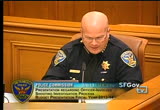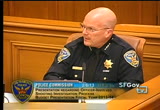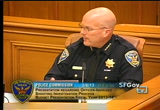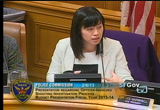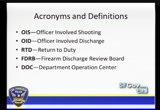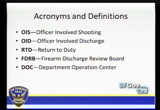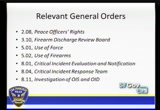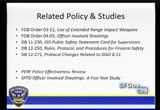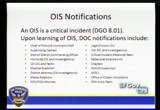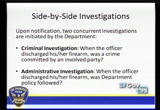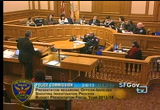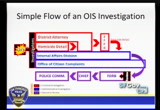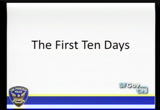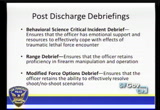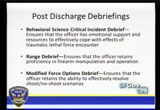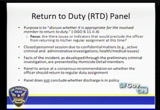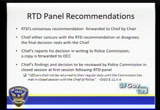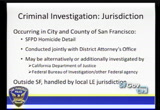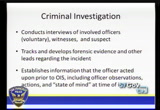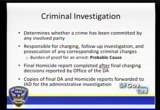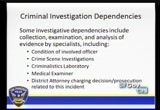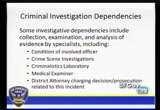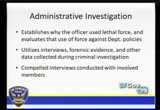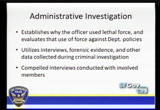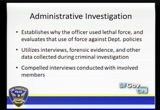tv [untitled] February 18, 2013 2:00am-2:30am PST
2:00 am
persons and firearms list. * it was in their paper that there are some 16,000 people in california who are prohibited persons. the way that it works, doj maintains an armed prohibited person system. it's called apps. it's a cross reference of the automated firearms system and cini cross referencing folks that shouldn't have guns. we were noticed back when this program started in 2011 that we had 516 folks that needed to be talked to. since then we have contacted all of them. we have recovered 81 guns that are no longer in their hands and other cases have been closed for some reasons like those with mental health issues once they're five years in duration, they fall off the list. some of the people on the list have actually either were deceased or died since. some people have restraining orders that caused them to be
2:01 am
prohibited. those orders have either expired or been withdrawn. some people have moved out of the city, in fact, one of our people that we contacted was a person that had been 51 50'd and had a firearm. we called to ask about the firearm. the person lived in marin. said he had the firearm. they went to marin. that person had 71 guns in his residence that are now property for safekeeping with the department of justice until his mental health condition is five years old. and the misdemeanor prohibitions have a 10 year shelf life and they fall off the list. so, currently we have no backlog in san francisco. the only cases for prohibited persons that we have yet to touch, we received six this month. one has been contacted -- one has been closed. one has said that he no longer has the gun. we have to make him sign a penalty of perjury form. stating that fact we have four that are new yet to talk to.
2:02 am
so, of the 516 originally they have all been investigated and monthly we close them out before the end of each month. so, san francisco is current as far as prohibited persons on that list. now, i am cautioned by inspector chin who does a terrific job for us coordinating this that the system isn't exactly accurate as there is no state registry for hand guns. and, so, it's only the hard file custodian of records for assault rifles that is really, really rock solid here in california. so, but as best we can, we follow-up on every lead that we get from the department of justice. and then i have captain o'leary who did a great job last week providing us with those numbers as far as officers, calls for service and we'll be comparing that one page that i promised you related to how we're doing with occ complaints in force in the police department versus actions taken. so, with that, i'm going to go to the next thing, which would
2:03 am
be the officer involved shooting presentation solicited by commissioner chan, which will be sergeant krudo and his team. >> if i could just give a little intro here so i can explain why i asked for this. commissioner carmen and myself were meeting on this and asked for this early last fall, i believe. and the idea thats as we had our officer involved shooting process and the firearm discharge review process, we had a number of department general orders linked to them. it looked like it might be time to review them and things we want to tinker with to make it ail smoother process. i think we had some questions as we were going through some of the officer-involved shooting reviews. so, that's part of this. and, so, the city attorney suggested we get a presentation from the department that explains these two processes so that we reeducate ourselves as well as the public as we look at the various department general orders linked to these two [speaker not understood]. that is the idea behind this, background information. keep this in mind as we're
2:04 am
looking at the different dgos. >> president mazzucco, commissioners, director hicks, chief sur, i have just been introduced. i'll be going over the process of [speaker not understood] investigations as we handle it with our department. okay. as we start, i want to lay some foundation, some of the terms we'll be using tonight and some of the policies that are involved in the process. some of the acronyms which are on the board here, ois which is officer involved shooting, and that will be defined really as an intentional discharge by the officer of his weapon. these are the current definitions that we're using. now, these changed in '09, august of '09. so, the definition of an ois is really an intentional discharge by the officer of his weapon
2:05 am
excluding at a dangerous animal, excluding a cry for alarm, which is permitted by our general orders under extreme, extremely unusual circumstances. but in the performance of his duties, the discharge firearm intentional discharge of firearm. the unintentional discharge of a firearm or accidental discharge of firearm that causes damage to property or injury to a person. excuse me. injury to a person. and the discharge oid, officer involved discharge would be -- so, that's the unintended accidental discharge doesn't cause injury. that would be the animal, dangerous animal. that would be the cry for alarm, [speaker not understood] exist. obviously discharges, for example, that would be normal in the scope of duty at the
2:06 am
range or whatever don't fall under this. return to duty and the firearm discharge review board are two review panels we'll talk about tonight that come into play. and i will mention the department operation center which is doc. that's sort of like a central hub of information. we're going to talk about what happens when the officer fires his weapon and [speaker not understood] notifications. just real quickly, you have these handouts in front of you, i believe, but some of the relevant general orders that come into play, this is not the absolute and final list, but these are some of the ones that we routinely deal with. department of general order 2.08, peace officer rights, remember, these have some administrative components. these investigations as well as criminal component. we'll talk about that. firearm discharge review board, use of force and use of firearms.
2:07 am
critical incident, any ois is considered critical incident. critical incident response comes into play with some of our dee pre-vtionings. investigation of ois and oid. obviously that's what we're talking about tonight. department [speaker not understood]. went the wrong way. other related policies would be field operations bureau order, 3-11 which is regarding the use of eriw. and i put that up there because that does come into play obviously in some of these incidents. that is a nonlethal option for officers. field operation bureau order 04 03 which is officer involved shootings and that's really kind of goes over the on scene management and the duties of the different field supervisors and whatnot at the time of an officer involved shooting. '09-239 -- excuse me, 11, now reissued at 12-271, that's the
2:08 am
change of definition as we talked about tonight where some of these things used to be called discharges. they're now considered an ois. so, we're talking about ois as we currently defined it. so, we'll talk about what happens when an ois occurs. as i mentioned, the moment an officer gets on the radio and says, officer involved shooting or gives some indication that's happened, process of notifications begins. an ois as i mentioned is considered critical incident and it's treated as a major crime. upon learning of an ois by dispatch, by phone, by radio or by phone, doc would begin making notifications. the notifications that you have which are listed on the board here, you have on your list, that's from the list that the department operation center keeps. they will notify all these
2:09 am
parties regarding the discharge. okay. i would point out these are some of the keys as far as the notifications. homicide, which will coordinate the criminal investigation along with the district attorney, the internal affairs and the occ handle administrative investigations related to the shooting. so, once the notification goes out, automatically two separate investigations begin and they're side by side. one is a criminal investigation which is looking at whether a crime was committed by an involved party, any party in the incident when the weapon was fired, when the officer shot the weapon. >> sorry, officer. would you prefer that we waited till the end to ask questions
2:10 am
or as you go along? >> it depends. i mean if it's something you need clarification, if i can give a quick one, if it's a little more, whatever works for you, commissioner. >> okay. i'm just looking at your ois notification. >> yes, sir. >> there seems to be a critical body missing from that ois critical incident notification. >> what are you looking for? >> the police commission. >> this is, this is the list, this is the list that i had. i may have omitted that. i wrote this off the list -- >> [speaker not understood] dgo to make sure. >> i could answer that for you, commissioner. what happens is when these notifications goes through the commaedction staff, the inspector notifies us immediately. >> that's why it should be on here. that's why it should be in that category. >> we get notification, okay. it's >> it's important for the public to know that, too. that's why i'm making the
2:11 am
point. >> thank you, sir. once the notification have gone out there is a criminal and administrative investigation that begins, side by side separate investigations. again, the criminal investigation is looking into when the discharge occurred, was a crime committed by an involved party. the administrative investigation is focused specifically on the officer and the discharge of the weapon and looking at whether department policy was followed. i prepared -- this is a flow chart, a real simple flow, but this is sort of how the process occurs. the red indicates the criminal investigation. the blue indicates the administrative investigation and then the purple is an executive review which is at the conclusion of the investigation. it should be noted that -- it
2:12 am
should be noted that information flows one direction. so, you're probably familiar from your hearings and disciplinary cases. the administrative investigators were privy to information developed by the criminal investigation, but that information doesn't flow the other direction. so, we piggyback on the criminal investigation, but i can't tell, for example, i can't ask a question vicariously through a homicide investigator. that make sense? okay. we'll get into more detail on the process. i want to cover the first ten days because we talked about this. after you've all heard the return to duty briefing which is usually within the first 10 days of an ois. so, i want to kind of cover this is in addition to one of the investigations. but in the first 10 days, several things are required to
2:13 am
happen for our general orders. the involved officer or officers are administratively reassigned for a minimum of 10 days. they are given administrative assignment. during this time if it hasn't already, it usually happens almost immediate -- well, contemporaneously with the incident. the night of the incident, the day of the incident, the homicide interview would be completed. the officer has to complete several post-discharge debriefings. we'll talk about those. and the return to duty panel is required to meet five business days after the ois. so, talked about the post discharge, post discharge debriefings. and there's three that an officer would routinely put an officer routinely through three debriefings afterward.
2:14 am
one is the critical incident debriefing and that's a meeting with our behavioral science unit. that's required to be done within 72 hours of the incident. and the officer meets with the -- the involved officer meets with the folks from the behavioral science unit and he is provided information about posttraumatic stress and about resources he that would be available to the officer. two other things that happened are a range debrief and a modified force options debrief. that's the simulator. the officer goes back out to the range, makes sure they retain the ability to effectively manipulate, physically manipulate the weapon. they were put through several shoot, no shoot scenarioses in the simulator to make sure that they retain the ability to navigate those correctly. the return to duty panel
2:15 am
convened, as i said, five business days -- excuse me, i think i jumped. it's five business days after the incident. and the purpose per the general orders is to discuss whether it is appropriate for the involved officer to return to duty. the focus there is either issues that have been discovered at this time that would preclude the officer from returning to his or her regular assignment. this is a closed personnel session because the confidential material that is being included in the panel that obviously would include the active investigations, health and medical issues. so, there's some hipaa issues there. the fact is they have been developed through the preliminary investigation of the homicide detail members. and the panel is to arrive at a consensus recommendation for the chief, although the officer
2:16 am
should return to the regular duty assignment. the panel does not conclude whether the discharge is in policy. obviously that is an active investigation. so, it would be preliminary to make that decision at that time. this is a composition of the return to duty panel. the deputy chief of administration is the chair and the involved members deputy chief's and commander are present. his or her commanding officer, the commanding officer of the risk management office, the internal affairs division, the homicide detail, the investigators and a representative from the behavioral science unit. the recommendations of the return to duty panel, return an officer to work forwarded to the chief for review. the chief can either concur with the recommendation or come up with his own decision. the chief reports the decision.
2:17 am
that's the return to duty presentation that you've heard. and a copy of that is forwarded to the occ. and the chief's finding and decisions are to be reviewed by the police commission in closed session at the first session following the return to duty panel. so, if you think about -- you know, the calendar, that's going to put that first 10 days, that puts us usually right around that point, first 10 days comes into play around there. entering to note because we're talking about the go or some of the background for the gos, one of the things that 81 1 section 2 part 4, they say the officers shall not be returned to regular duty until the commission has met in closed session with the chief of police. i just want to point out that this has been difficult in some cases for us to get that presented to the commission, you know, in the first meeting after the rtd sometimes the commission is dark or there is a public session where -- maybe
2:18 am
even there is not a quorum. so, i just wanted to mention that particular aspect. so, again, going back to the notifications, homicide is notified. so, we're going to talk about the process in san francisco the jurisdiction for investigating the criminal side of an officer involved shooting falls to the local law enforcement jurisdiction. in san francisco that's obviously our department and it's assigned to our homicide detail. that is conducted jointly with the district attorney's office and it may be alternatively or additionally investigated by department of justice, fbi, or another federal agency. if it happened outside of san francisco, it's investigated by the local law enforcement agency according to their own
2:19 am
parameters. all of these investigations, all the answers -- i just -- they're complex, sensitive thorough investigations and it is really important for a matter of maintaining public trust and confidence. we want to make sure we're doing these things thoroughly, doing them properly and correctly. we put a lot of resources into them. the criminal investigation conducts -- the first night, first day of the incident, we're going to conduct interviews with the involved officers. that is a voluntary -- it is a voluntary interview that the officer gives. with the involved officers, the witnesses, sworn and nonsworn and the suspect if the suspect is obliging. the criminal investigation just as with any other would track and develop forensic evidence regarding leaves of the incident. it is important in these investigations on both the administrative and the criminal
2:20 am
side to establish information if the officer acted on prior to the ois. what did they know at the time including their observations, actions and state of mind at the time of the incident. the criminal investigation will determine whether a crime has been committed by an involved party. the investigators responsible for the charging follow-up investigation and prosecution of any corresponding criminal charges from any involved party. and as an example, let's say it happened in the course of -- well, bank robbery may not, fbi may not be involved with that. let's say a robbery, purse snatching, they would develop the case for the purse snatching. does that make sense? okay. the final homicide report is not completed until after charging decision is made by the district attorney. so, again, the criminal investigation starts. our homicide is notified. so is the d.a..
2:21 am
the d.a. conducts their own investigation. they're doing it. they're at the interviews. we'll get into it a little bit. homicide, their investigation is forwarded. the findings in the investigation forwarded to the d.a. who then would review their case and make a decision whether or not any charges will be made in the case. the final d.a. report and the homicide report is then forwarded to iab for the administrative investigation. obviously that would be a component of our investigation. whether or not there was some criminal activity that was involved. i want to mention some of the dependency for the criminal investigation. probably the only thing that i'd like less than coming up here and telling you we're still waiting for a declination letter, seeing my work queue back up. but understand as i said these are complicated, complex investigations and there are
2:22 am
some dependencies. the condition of the officer may be a factor. so, the ability to interview the officer in a timely manner could be an issue. crime scene investigations, their analysis of evidence collected and same with criminalistics lab. we're looking in large part at criminalistic's lab, the weapons involved. the medical examiner report, that takes -- that takes its time. the toxicology, oftentimes i know they go back and they go into prior medical history and things like that. so, and then the district attorney's charging decisions and any prosecution that's related to the incident, those are all factors that affect the criminal side of the ois investigation. president ma suectiontion a stole a little of my thunder last week. you mentioned the deal when we had the ois report.
2:23 am
you mentioned the d.a.'s office. it's really important that -- for us that the d.a. does a thorough review of the investigation because that's the objective third-party eye. you know, they do -- they initiate an investigation at the time they're notified of the shooting. they do some joint work with our homicide unit. they are at the scene. they participate in the interview that the officers of the witnesses, of the suspect. and then they draw their own preliminary conclusion. they conduct their own investigation. they then review what the homicide investigator presented, their burden of proof, as you know, beyond a reasonable doubt. and the d.a. would decide any charging in the matter of any involved party. and as i mentioned, it provides that objective independent analysis of the incident in the
2:24 am
criminal investigation. so, we feel that's important. once they finish, their information as i mentioned is their conclusionses are forwarded to the administrative investigator. the administrative investigator at the same time as the on-site investigation, two joint -- two separate concurrent investigations are happening. so, regardless of where it happens, the jurisdiction belongs to the san francisco police department if it's one of our members. so, something that may happen out of county, out of city and county would still be investigated by san francisco's internal affairs. investigated criminally by whatever agency would have that jurisdiction, but we would have jurisdiction, the internal affairs division on the administrative side. it may be concurrently investigated by the office of citizen complaints. the occ investigators are
2:25 am
initially dispatched to the case, to the incident. they're out there at the scene as are we. a receipt of the complaint is required to open a formal investigation. again, the administrative investigation is really there to establish why the officer used leave of force to evaluate that use of force against the department policies. we utilize interviews, forensic evidence and other data collected in the course of the criminal investigation. so, we have some of the same dependencies that homicide has, we're piggybacking. >> quick question for you. the next part of the slide say compelled interviewed conducted with involved members. can you explain to the public the difference between when there's -- a we talked about, the criminal investigation and administrative investigation. can you explain to the public that, for example, the officers like any other individual has a fifth amendment privilege and do not need to speak to the prosecutors.
2:26 am
however, by law, part of the administrative, they have to talk to pursuant to general orders our investigators, is that correct? >> that's correct. you jumped the gun. you put it in better terms than i would have, commissioner. but yes, we conduct a separate interview for the involved officer. that interview is a compelled interview. the officer is given [speaker not understood], read the miranda rights. they're told they don't have an option of taking the fifth, of keeping quiet, of not answering our questions. on the penalty of up to and including losing their job. so, because of that, we're requiring them to make a statement. we are requiring them to basically give up their constitutional rights. so, that become a compelled statement which is retained in the administrative investigation. it can't go to the criminal investigation. it can't be used -- their statement to the administrative
2:27 am
investigator to generalize, can't be -- [speaker not understood] you understand, but can't be used to, you know, against the officer in a criminal investigation related to that specific incident except as a matter of impeachment or allowed by a judge. >> is that why information flows one way per that flow chart you showed us? >> that's also true of any disciplinary investigation where there could be a criminal component. it flows one way. there are state laws regarding, you know, the peace officer, peace officer rights and the fact that you have labor file, thing like that. it can flow one direction, it can't flow the other. so, that's not unique to the ois investigation. okay. okay. so, any questions so far?
2:28 am
sorry. the administrative investigation again is determining whether the use of lethal force was in accordance with the department of policy. our burden of proof in administering the investigation is the preponderance of the evidence. investigative findings, recommendationses are prepared by the investigator in a final report. this will include obviously the criminal information we received. that's part of the reason we trail behind the criminal investigation obviously if there was some criminal misconduct, that would be a factor in the administrative investigation. so, the investigative findings were then presented to the quarterly held firearm discharge review board. you sat through those reports as well. so, you're familiar with that a little bit. okay. some of the investigator dependencies we touched on, again would be the district attorney report and the final
2:29 am
homicide report. >> those are the big ones. >> once we have the final product, we've got the administrative report completed. it's presented to a firearms discharge review board which is held every quarter. the firearm discharge review board is authorized in department general order 310 and it's referenced in 81 1. so, both those general orders have some information on how it's conducted and not necessarily -- doesn't jive easily. >> i have a question. >> yes. >> and you might have talked about this, but the significance of the difference between the standard of proof in a criminal case is beyond a reasonable doubt and your proof is preponderance? >> ours is preponderance 51%. >> 51%. >> yeah. we more likely to believe or not believe than to not believe or believe. so, there's different levels that each investigative
35 Views
IN COLLECTIONS
SFGTV: San Francisco Government Television Television Archive
Television Archive  Television Archive News Search Service
Television Archive News Search Service 
Uploaded by TV Archive on

 Live Music Archive
Live Music Archive Librivox Free Audio
Librivox Free Audio Metropolitan Museum
Metropolitan Museum Cleveland Museum of Art
Cleveland Museum of Art Internet Arcade
Internet Arcade Console Living Room
Console Living Room Books to Borrow
Books to Borrow Open Library
Open Library TV News
TV News Understanding 9/11
Understanding 9/11